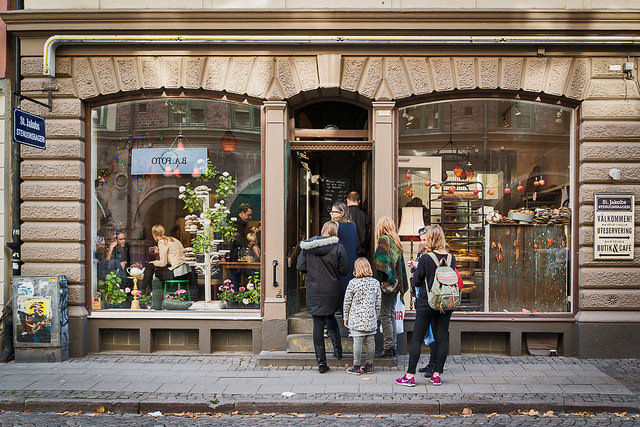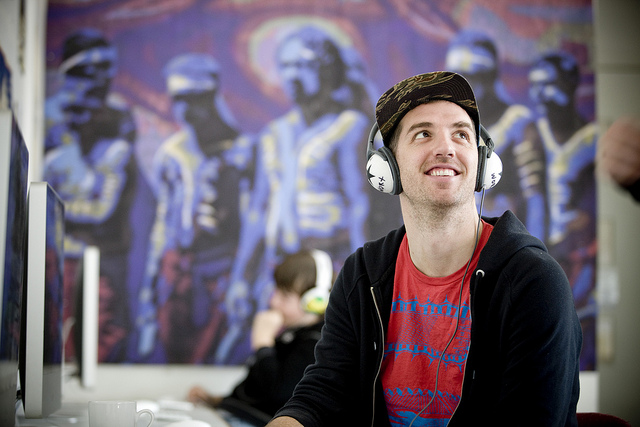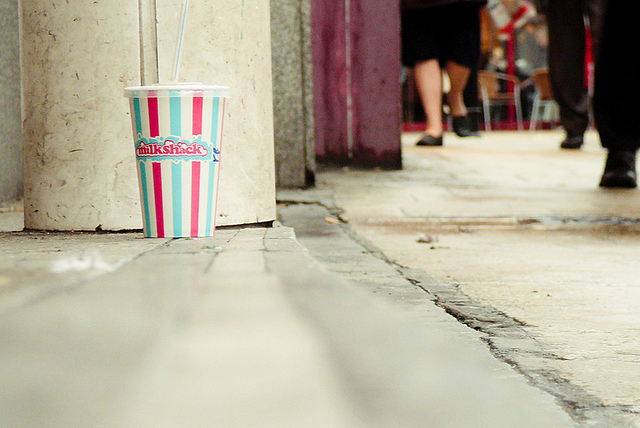Unlock the Magic in Your Story Now
Get the Free 20 questions to Ask Before Launching Your Idea workbook when you sign up for occasional updates.
Get the Free 20 questions to Ask Before Launching Your Idea workbook when you sign up for occasional updates.
Articles filed in: Strategy
The Best Fit
filed in Strategy
 Sometimes we take on projects or clients that are a bad fit. Work that doesn’t energise us or customers that don’t value us. It’s hard to pay attention to the reasons why things aren’t working out when you’re knee-deep in the situation. But it’s important to try.
Sometimes we take on projects or clients that are a bad fit. Work that doesn’t energise us or customers that don’t value us. It’s hard to pay attention to the reasons why things aren’t working out when you’re knee-deep in the situation. But it’s important to try.
We discover how we work best by paying attention to the projects that didn’t turn out as we hoped. Every unconscious compromise is a result of a failure to consciously set boundaries. It’s up to us to understand, then create the circumstances that allow us to do our best work.
Give yourself permission to set a high bar. Save your best work for the projects and people where you can make the most difference. Who or what is the best fit for you, and why?
Image by Saigon
Culture Creation
filed in Strategy
 Our usual Friday morning workout instructor is on holiday for a month. The first sign that something has changed in his absence is a drop in the number of people who attend. The time slot is the same. The workout is identical. But fewer people are motivated to come.
Our usual Friday morning workout instructor is on holiday for a month. The first sign that something has changed in his absence is a drop in the number of people who attend. The time slot is the same. The workout is identical. But fewer people are motivated to come.
We’re not just getting up early on Friday to build muscles or get fitter—we’re there for the feeling we get from working out together. The leader sets the tone. In the beginning, he is responsible for the energy in the room. The way he shows up changes how we respond and what happens next.
How we go about our work can have as much impact on our results as the work itself. Our culture is changed not only because of what we do but because of the way we do it. Culture is born when someone shows up authentically as only he or she can, leaving his or her mark on the work and encouraging other people to do the same.
The who and the how have the power to define the what.
Image by Eli Christman
The Extra Mile
filed in Strategy
 In a challenging marketplace, it’s tempting to compete on value by aligning with what other businesses do. The companies that will win and keep customers in the future are the ones who do the things their competitors won’t do.
In a challenging marketplace, it’s tempting to compete on value by aligning with what other businesses do. The companies that will win and keep customers in the future are the ones who do the things their competitors won’t do.
It’s easier to keep step than it is to go the extra mile. That’s why it’s exactly what you should do.
Image by Hector Hannibal
The Attraction Retention Conundrum
filed in Storytelling, Strategy
 The line outside the new patisserie snaked around the block. It never seemed to get shorter. The word that they were giving away free muffins on opening day had travelled fast and the owner wasn’t sure she’d have enough for everyone. The launch promotion had worked that was for sure!
The line outside the new patisserie snaked around the block. It never seemed to get shorter. The word that they were giving away free muffins on opening day had travelled fast and the owner wasn’t sure she’d have enough for everyone. The launch promotion had worked that was for sure!
Now she just had to figure out how to keep people coming back.
What attracts any customer isn’t necessarily what keeps the right customer coming back. Getting people to notice or to try something new can feel like the hard part of building and marketing a business.
The hard part is creating something that draws people to you on a dreary, wet Wednesday because you made them feel like they belonged. Sustainable businesses and beloved brands build for day two customers—not only for the masses who show up on day one.
Image by Susanne
Show Your Story
filed in Marketing, Storytelling, Strategy
 In the early 1960s, a Brooklyn tax clerk, named Jean Nidetch discovered a powerful and underutilised marketing technique. When Jean, who had been overweight for years, lost thirty kilos her friends asked her how she’d done it. She began sharing her diet secrets with half a dozen friends in her apartment. Jean’s diet club soon outgrew the apartment. The before and after transformations of successful members were all the marketing that was required to convince people to join. It was from these humble beginnings that Weight Watchers was born.
In the early 1960s, a Brooklyn tax clerk, named Jean Nidetch discovered a powerful and underutilised marketing technique. When Jean, who had been overweight for years, lost thirty kilos her friends asked her how she’d done it. She began sharing her diet secrets with half a dozen friends in her apartment. Jean’s diet club soon outgrew the apartment. The before and after transformations of successful members were all the marketing that was required to convince people to join. It was from these humble beginnings that Weight Watchers was born.
The before and after photo has been used to market diet and beauty products for decades. And even though transformation stories would work in the marketing of services, we don’t use them often.
There is no better way to tell your story than to show people who they will become in the presence of your product. What was your customer’s life like before he used your product or service?
What’s his new reality?
That’s your story.
Image by Social Traders
Visible Vs. Memorable
filed in Storytelling, Strategy
 When my friend Mark opened his bakery, he was faced with a marketing dilemma. Should he blow his marketing budget on a single print advert that would cost him several thousand dollars or should he invest that money in something else? The promise of brand validation and the creation of mass awareness made the print advert tempting. But Mark wasn’t aiming to build a business that was more visible. He wanted to connect with his community around memorable experiences.
When my friend Mark opened his bakery, he was faced with a marketing dilemma. Should he blow his marketing budget on a single print advert that would cost him several thousand dollars or should he invest that money in something else? The promise of brand validation and the creation of mass awareness made the print advert tempting. But Mark wasn’t aiming to build a business that was more visible. He wanted to connect with his community around memorable experiences.
So instead of spending his marketing budget on conventional advertising, Mark created the weekly bread basket. The basket contained a week’s supply of delicious fresh bread which one lucky customer got to take home and enjoy. But here’s the best part. Each customer who received the basket nominated the next person to get one and recorded why they chose their friend or neighbour in a notebook at the bakery. The bread basket didn’t just spread the word about Mark’s bakery.
It connected friends and neighbours and made them feel like they mattered.
The kind of marketing we invest in sends a signal the kind of company we are aspiring to build. The immediacy of gaining awareness feels like progress.
But awareness isn’t what keeps customers coming back.
Image by scattered view
Sell It Like You Made It
filed in Storytelling, Strategy
 The days when you could go down to the Milofsky’s Hardware supplies, and come away with a couple of screws carefully wrapped in brown paper, which were perfect for the job, are long gone. The days when Mrs O’Hanlon didn’t mind taking this heavy glass jar, then that one, down from the shelves of her sweet shop for a kid trying to make her ten pence go as far as possible are long gone too. I miss them. We all do— even if we never lived them.
The days when you could go down to the Milofsky’s Hardware supplies, and come away with a couple of screws carefully wrapped in brown paper, which were perfect for the job, are long gone. The days when Mrs O’Hanlon didn’t mind taking this heavy glass jar, then that one, down from the shelves of her sweet shop for a kid trying to make her ten pence go as far as possible are long gone too. I miss them. We all do— even if we never lived them.
Many of us have the chance to sign our work—to put our name over the door figuratively. For many others, the work they do is anonymous. They don’t have the opportunity to put their name to it. But in either case, however you work and whatever you have a part in creating, building or selling, it’s made better when you sell it like you made it.
When we take ownership of our work, our story and the change we’re here to create the people on the receiving end know. And that sense that the product or service was made and sold with care and empathy and love makes the experience better. It makes us better too.
Image by Edna Winti
Transactions Vs. Experiences
filed in Marketing, Storytelling, Strategy
 The hotel was nothing to write home about. You couldn’t really fault it either. The facilities, which matched the hotel’s star rating were as described. The room was clean. The bed was comfortable. The staff were efficient and polite. But—you knew there was a ‘but’ coming. The place lacked a spirit of generosity. It had no soul. There was no magic. It was as if the management had deliberately planned to deliver the minimum required to meet spec and no more. I got a room, and the hotel got my credit card details. A transaction took place.
The hotel was nothing to write home about. You couldn’t really fault it either. The facilities, which matched the hotel’s star rating were as described. The room was clean. The bed was comfortable. The staff were efficient and polite. But—you knew there was a ‘but’ coming. The place lacked a spirit of generosity. It had no soul. There was no magic. It was as if the management had deliberately planned to deliver the minimum required to meet spec and no more. I got a room, and the hotel got my credit card details. A transaction took place.
Every business has a story to tell about how discerning, disgruntled and sometimes downright demanding customers have become. It’s as if peoples’ expectations know no bounds. There’s another side to this story though. Our side. The story about what’s at stake for us as leaders, entrepreneurs and marketers. When we deliver the minimum required and deal only in transactions, we’re not only disappointing customers—we’re selling ourselves short in all kinds of ways that can’t be measured on a balance sheet at the end of the quarter.
Our customers subconsciously mirror our attitudes and behaviour. When we deal in transactions, we become transactional brands. When we go above and beyond, people know. When we are generous, they respond.
My friend James runs a thriving cafe in Fitzroy Gardens called KereKere. The cafe gets its name from the Fijian custom of giving without expecting anything in return. KereKere customers leave feeling that they got more than they paid for because James has intentionally built a business that creates experiences. James doesn’t believe in simply processing transactions.
The inadequacy of the adequate isn’t just that it leaves customers feeling flat, it’s that it denies us the opportunity to do our best, most meaningful work.
Image by Linh Nguyen
Marketing Efficacy And Expectations
 When ‘meal replacement’ shakes first came to market they seemed like the answer to a dieter’s prayers. Replacing one or two regular meals with a calorie counted milkshake meant ingesting fewer calories, resulting in rapid weight loss. Meal replacements worked for some people for a little while. Those first few pounds often ‘fell off’. But monotony soon overcame motivation. Dieters gained weight as soon as they went back to eating real food.
When ‘meal replacement’ shakes first came to market they seemed like the answer to a dieter’s prayers. Replacing one or two regular meals with a calorie counted milkshake meant ingesting fewer calories, resulting in rapid weight loss. Meal replacements worked for some people for a little while. Those first few pounds often ‘fell off’. But monotony soon overcame motivation. Dieters gained weight as soon as they went back to eating real food.
The efficacy of the product failed to meet expectations. It’s not that the product didn’t work.
It’s just that it didn’t do everything the customer hoped it would do.
We have a similar problem when it comes to marketing. We sometimes expect our marketing messages to do too much heavy lifting and are disappointed with the results. It’s almost impossible for a marketing message to take a customer from awareness to action in a single leap. And yet, becoming the outlier is the holy grail of marketing. We dream of being the bestseller, the blockbuster, the breakthrough. Mostly we’re disappointed by our results.
Often the problem isn’t the efficacy of our marketing—it’s our expectations about the kind of change it’s possible to create, with the resources we have, in the time we’ve allowed. Two questions worth asking at the outset then—what are we asking this marketing message to do and is it reasonable to expect the result we want in the time we have?
Image by Paul Kelly
Being Seen And Heard
 The numbers vary, but the trend is unmistakable. The average consumer is subjected to more marketing messages every day. In a world where it’s harder to get noticed marketers have responded by trying to be more visible. Being noticed is the goal of most marketing.
The numbers vary, but the trend is unmistakable. The average consumer is subjected to more marketing messages every day. In a world where it’s harder to get noticed marketers have responded by trying to be more visible. Being noticed is the goal of most marketing.
The irony is five seconds in the spotlight doesn’t make or break a career or a company. It’s the five years of work that preceded those five seconds that make all the difference.
Our goal isn’t simply to been seen and heard—it is to do work that’s worthy of being seen and heard.
Image by Blahu